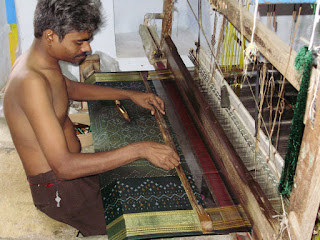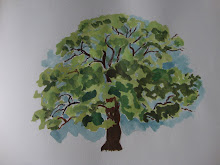The weaving is done by the villagers in their homes. The homes are kept open and one can walk in and watch them weaving. They are used to tourists and carry on with their work. Some of them are communicative and answer your questions, while some just do not want to be disturbed, but at the same time allow you to wander around .
These are some of the pictures taken in different homes, and most of the steps in the weaving process have been captured.
 yarn being wound from hank to bobbin
yarn being wound from hank to bobbin Weft on the tie-dye frame where the design is marked with charcoal . Designs are generally worked out on graph paper. The areas where the original colour is to be retained is wrapped with water repellent material like the inner tubes of a bicycle which is cut into strips. This has to be done with great care for the design to be achieved.
Weft on the tie-dye frame where the design is marked with charcoal . Designs are generally worked out on graph paper. The areas where the original colour is to be retained is wrapped with water repellent material like the inner tubes of a bicycle which is cut into strips. This has to be done with great care for the design to be achieved. After wrapping, the threads are dyed. Above the threads are ready for the dyeing process
After wrapping, the threads are dyed. Above the threads are ready for the dyeing process Dyeing of thread in progress
Dyeing of thread in progress .....and then hung to dry. According to the design the yarn is dyed in different colour as many times as required. After which the tubings (ties) are removed to expose the parts that are left undyed.
.....and then hung to dry. According to the design the yarn is dyed in different colour as many times as required. After which the tubings (ties) are removed to expose the parts that are left undyed. The tie-dyed yarn is placed on the frame for rewinding...
The tie-dyed yarn is placed on the frame for rewinding...
The yarn is then wound again. The warp is placed on the loom and the weft is placed on the shuttle . And the weaving commences...
One came back from the village in awe of the effort of the weavers. A sari is ready after 5-7 days of continuous and precise weaving.
I have always appreciated handloom fabrics and they form a major part of my wardrobe. And hope in my own way I have contributed to keeping the handloom industry alive.





Lovely post. Really what a joy to see the process. Does each household make an entire finished product - start to finish ? or does the process itself get split between multiple housholds? Its amazing to see this organic process which takes a week to produce is still thriving.Did not see any children in the pics?Is that a consistent observation for you too?
ReplyDeleteYes, each household makes the entire finished product. And strangely, as you mentioned, there were no children around. One teenager took us around. Some of them are helpers at the shops that sell the ready goods. I would like to think the others were at school. And there were the temporary hammocks ( a sari hung from a ceiling hook) but no babies in them. And the village was really clean and neat!
ReplyDeleteThe pictures showing each stage of the process are wonderful. It must have been interesting to see how the weavers actually do their work.
ReplyDeleteHow nice that in this age of machine-made goods, this traditional way of weaving sarees is still followed!
Beautiful ma! I hope you contributed more to the industry by buying another sari :)
ReplyDeleteWow. That fabric is exquisite! I bet it is well priced too - I would have spent a fortune! Usually I don't like shopping or spending money but I have a real weakness for Indian fabrics and clothing.
ReplyDeleteGreat contribution to the textile industry!
ReplyDelete(btw how many sarees did you buy?)
No, I did not buy any saris. But did buy some bed sheets. Lovely ones. And some material. Thought I would help them by not asking for a discount ( infact at a shop I refused the discount) only to walk into another place to find it priced much cheaper! Products bought at the weavers' houses would have been cheaper without the middle man benefitting, but they did not have stock and the textiles were in a half finished stage. But recession has affected them too. Hardly any consumers!
ReplyDeleteWhat a wonderful post, Radha. I like village saris so much. Today I rec'd a bag I'd left overseas and inside was my favorite sari, one made in Phuliya village just down the road....love it....
ReplyDeleteLovely article. Sad part is this art is slowly dieing due to lack of proper support and competition.
ReplyDeleteI would love to visit this place! Nice story
ReplyDelete